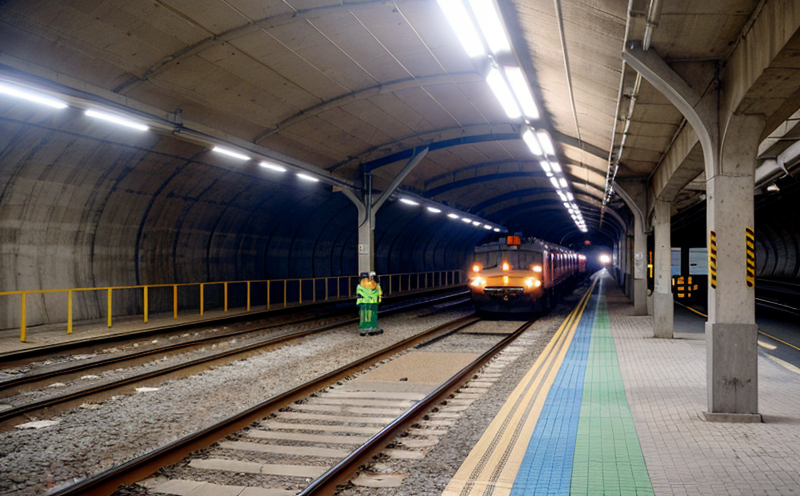EN 1993 Fatigue Testing of Steel Railway Bridges
The European standard EN 1993, part of Eurocodes, provides comprehensive guidelines for the structural design of railway bridges. One critical aspect of this standard is fatigue testing, which ensures that steel railway bridges can withstand repeated loading and environmental stresses without failure over their expected lifespan.
Fatigue testing involves subjecting materials or structures to cyclic loading until they fail. This process assesses how well a structure can handle the dynamic loads it will encounter during its operational life. For steel railway bridges, this is particularly important due to the high-frequency and high-stress nature of train traffic.
The EN 1993 fatigue testing procedure typically follows these steps:
- Specimen Preparation: The bridge components or full-scale models are prepared according to the standard specifications. This includes ensuring the material properties and dimensions meet the required criteria.
- Cyclic Loading: The specimens are subjected to cyclic loading cycles that replicate real-world stress conditions experienced by railway bridges. The loading can range from low-cycle fatigue (LCF) to high-cycle fatigue (HCF).
- Data Collection: Sensors and monitoring equipment capture the behavior of the specimen under load, including strain, displacement, and force.
- Failure Analysis: The collected data are analyzed to determine the fatigue life of the material or structure. This includes identifying any crack initiation and propagation points.
- Reporting: A detailed report is prepared summarizing the test results, including any deviations from expected behavior and recommendations for improvement if necessary.
The EN 1993 fatigue testing process ensures that railway bridges not only meet current safety standards but also anticipate future challenges. This helps in enhancing the reliability and longevity of these critical infrastructure elements.
Our laboratory adheres strictly to this standard, ensuring accurate and reliable results. Our expertise lies in providing comprehensive services that align with international best practices.
Scope and Methodology
The scope of EN 1993 fatigue testing encompasses a wide range of materials used in railway bridges, focusing primarily on steel structures due to their prevalence. The methodology involves several key steps:
- Material Selection: High-quality steels are selected for the test specimens based on their mechanical properties and expected use.
- Loading Conditions: Realistic loading conditions are simulated, including static and dynamic loads that replicate actual operational stresses.
- Sensor Placement: Sensors are strategically placed to monitor critical areas of stress concentration. This ensures accurate data collection during the testing process.
- Data Analysis: Advanced computational techniques are used to analyze the collected data, providing insights into the fatigue behavior of the materials under test.
- Reporting and Compliance: A detailed report is prepared, ensuring compliance with EN 1993 and any additional regulatory requirements. This report serves as a critical document for decision-making and future improvements.
The methodology employed by our laboratory ensures that the testing process is both rigorous and accurate, providing reliable data that can be used to enhance the design and construction of railway bridges.
Eurolab Advantages
Our laboratory offers several advantages when it comes to EN 1993 fatigue testing:
- Expertise and Experience: Our team of engineers and technicians is highly experienced in conducting this type of testing, ensuring accurate results.
- State-of-the-Art Facilities: We have the latest equipment and technology to perform these tests accurately and efficiently.
- Comprehensive Reporting: Our reports are detailed and provide a clear understanding of the test outcomes, helping our clients make informed decisions.
- Timely Delivery: We understand the importance of timely delivery, ensuring that our services do not delay project timelines.
- Custom Solutions: We offer custom testing solutions tailored to specific client needs and requirements.
- Regulatory Compliance: Our laboratory is fully compliant with all relevant standards and regulations, providing peace of mind for our clients.
- Collaborative Approach: We work closely with our clients throughout the testing process, ensuring their objectives are met effectively.
Our commitment to excellence ensures that we provide high-quality services that meet or exceed client expectations.
Customer Impact and Satisfaction
The impact of EN 1993 fatigue testing on our customers is significant. By ensuring compliance with international standards, we help our clients:
- Enhance Safety: Our testing ensures that railway bridges are safe and reliable, reducing the risk of accidents and failures.
- Prolong Lifespan: By identifying potential weak points early on, we help extend the lifespan of railway bridges, reducing maintenance costs.
- Meet Regulatory Requirements: We ensure that all tests comply with relevant standards, helping clients avoid legal issues and penalties.
- Improve Design: The insights gained from our testing can be used to improve future designs, making structures more robust and efficient.
- Enhance Reputation: By demonstrating a commitment to quality and safety, we help our clients build a positive reputation in the industry.
- Increase Efficiency: Our services streamline the design and construction process, ensuring that projects are completed on time and within budget.
Customer satisfaction is at the heart of everything we do. We strive to provide exceptional service that meets or exceeds our clients' expectations.





